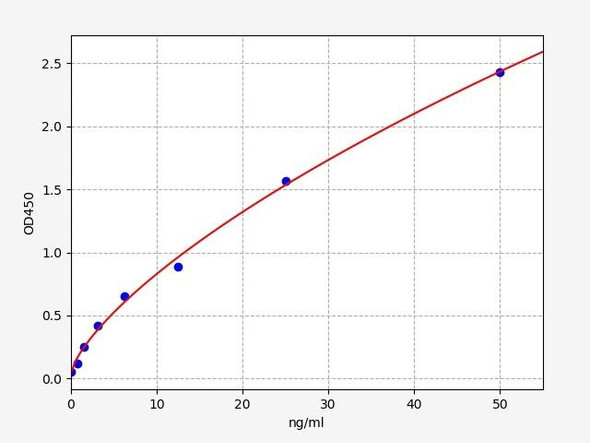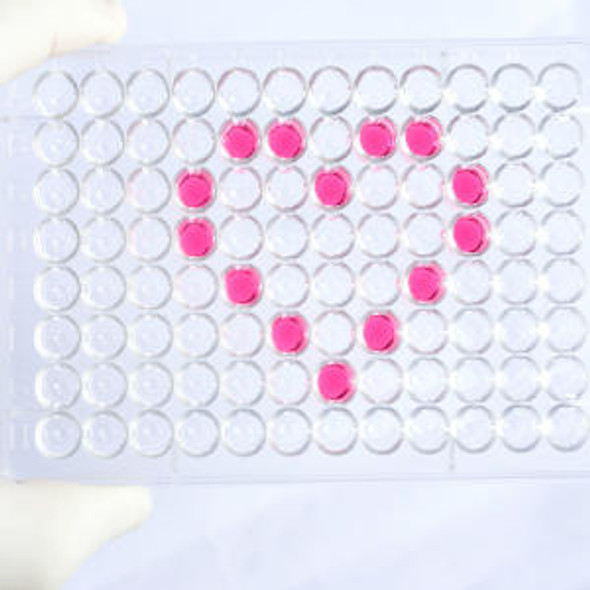Human HTRA2 (Serine protease HTRA2, mitochondrial)ELISA Kit (HUFI03876)
- SKU:
- HUFI03876
- Product Type:
- ELISA Kit
- Size:
- 96 Assays
- Uniprot:
- O43464
- Sensitivity:
- 18.75pg/ml
- Range:
- 31.25-2000pg/ml
- ELISA Type:
- Sandwich ELISA, Double Antibody
- Synonyms:
- Serine protease HTRA2, mitochondrial, High temperature requirement protein A2, HtrA2, Omi stress-regulated endoprotease, Serine protease 25, Serine proteinase OMI, OMI, PRSS25, HTRA2
- Reactivity:
- Human
Description
| Product Name: | Human HTRA2 (Serine protease HTRA2, mitochondrial)ELISA Kit |
| Product Code: | HUFI03876 |
| Size: | 96 Assays |
| Alias: | Serine protease HTRA2, mitochondrial ELISA Kit, High temperature requirement protein A2 ELISA Kit, HtrA2 ELISA Kit, Omi stress-regulated endoprotease ELISA Kit, Serine protease 25 ELISA Kit, Serine proteinase OMI ELISA Kit, OMI ELISA Kit, PRSS25 ELISA Kit, HTRA2 ELISA Kit |
| Detection method: | Sandwich ELISA, Double Antibody |
| Application: | This immunoassay kit allows for the in vitro quantitative determination of Human HTRA2 (Serine protease HTRA2, mitochondrial)ELISA Kit concentrations in serum plasma and other biological fluids. |
| Sensitivity: | < 18.75pg/ml |
| Range: | 31.25-2000pg/ml |
| Storage: | 4°C for 6 months |
| Note: | For Research Use Only |
| Recovery: | Matrices listed below were spiked with certain level of Human HTRA2 (Serine protease HTRA2, mitochondrial)ELISA Kit and the recovery rates were calculated by comparing the measured value to the expected amount of Human HTRA2 (Serine protease HTRA2, mitochondrial)ELISA Kit in samples. | ||||||||||||||||
| |||||||||||||||||
| Linearity: | The linearity of the kit was assayed by testing samples spiked with appropriate concentration of Human HTRA2 (Serine protease HTRA2, mitochondrial)ELISA Kit and their serial dilutions. The results were demonstrated by the percentage of calculated concentration to the expected. | ||||||||||||||||
| |||||||||||||||||
| CV(%): | Intra-Assay: CV<8% Inter-Assay: CV<10% |
| Component | Quantity | Storage |
| ELISA Microplate (Dismountable) | 8×12 strips | 4°C for 6 months |
| Lyophilized Standard | 2 | 4°C/-20°C |
| Sample/Standard Dilution Buffer | 20ml | 4°C |
| Biotin-labeled Antibody(Concentrated) | 120ul | 4°C (Protect from light) |
| Antibody Dilution Buffer | 10ml | 4°C |
| HRP-Streptavidin Conjugate(SABC) | 120ul | 4°C (Protect from light) |
| SABC Dilution Buffer | 10ml | 4°C |
| TMB Substrate | 10ml | 4°C (Protect from light) |
| Stop Solution | 10ml | 4°C |
| Wash Buffer(25X) | 30ml | 4°C |
| Plate Sealer | 5 | - |
Other materials and equipment required:
- Microplate reader with 450 nm wavelength filter
- Multichannel Pipette, Pipette, microcentrifuge tubes and disposable pipette tips
- Incubator
- Deionized or distilled water
- Absorbent paper
- Buffer resevoir
| UniProt Protein Function: | HTRA2: a serine proteinase that normally resides in mitochondrial membranes. It exists in two populations in mitochondria: as an unprocessed form probably attached to the inner mitochondrial membrane through a N-terminal transmembrane domain, and as a processed form containing a reaper motif at its N-terminus. Following apoptotic stimuli it is autoproteolytically activated and released into the cytosol, where it promotes programmed cell death in caspase-dependent and -independent manners. The amino-terminal reaper motif binds to the IAP (inhibitor of apoptosis) proteins cIAP1, cIAP2, and and XIAP, disrupting IAP-caspase complexes in a manner similar to Smac/DIABLO. Phosphorylation by the protein kinase Akt attenuates its serine protease and pro-apoptotic activities. The PDZ domain mediates interaction with Mxi2, an alternatively spliced form of the p38 stress-activated kinase. In contrast to its pro-apoptotic effects, targeted deletion in mice indicates that it is involved in protection against cell stress in striatial neurons. Defects in HTRA2 are the cause of Parkinson disease 13 (PARK13). Four alternatively spliced human isoforms have been described. |
| UniProt Protein Details: | Protein type:Protease; Mitochondrial; Membrane protein, integral; EC 3.4.21.108 Chromosomal Location of Human Ortholog: 2p12 Cellular Component: chromatin; cytoskeleton; cytosol; endoplasmic reticulum membrane; internal side of plasma membrane; membrane; mitochondrial intermembrane space; mitochondrion; nucleus Molecular Function:peptidase activity; protein binding; serine-type endopeptidase activity; serine-type peptidase activity Biological Process: cellular protein catabolic process; DNA damage response, signal transduction resulting in induction of apoptosis; negative regulation of cell cycle; positive regulation of apoptosis; positive regulation of caspase activity; protein autoprocessing; proteolysis Disease: Parkinson Disease 13, Autosomal Dominant, Susceptibility To |
| NCBI Summary: | This gene encodes a serine protease. The protein has been localized in the endoplasmic reticulum and interacts with an alternatively spliced form of mitogen-activated protein kinase 14. The protein has also been localized to the mitochondria with release to the cytosol following apoptotic stimulus. The protein is thought to induce apoptosis by binding the apoptosis inhibitory protein baculoviral IAP repeat-containing 4. Nuclear localization of this protein has also been observed. Alternate splicing of this gene results in multiple transcript variants encoding different isoforms. [provided by RefSeq, Mar 2016] |
| UniProt Code: | O43464 |
| NCBI GenInfo Identifier: | 17376879 |
| NCBI Gene ID: | 27429 |
| NCBI Accession: | O43464.2 |
| UniProt Secondary Accession: | O43464,Q9HBZ4, Q9P0Y3, Q9P0Y4, |
| UniProt Related Accession: | O43464 |
| Molecular Weight: | 39,914 Da |
| NCBI Full Name: | Serine protease HTRA2, mitochondrial |
| NCBI Synonym Full Names: | HtrA serine peptidase 2 |
| NCBI Official Symbol: | HTRA2 |
| NCBI Official Synonym Symbols: | OMI; PARK13; PRSS25 |
| NCBI Protein Information: | serine protease HTRA2, mitochondrial |
| UniProt Protein Name: | Serine protease HTRA2, mitochondrial |
| UniProt Synonym Protein Names: | High temperature requirement protein A2; HtrA2; Omi stress-regulated endoprotease; Serine protease 25; Serine proteinase OMI |
| Protein Family: | Serine protease |
| UniProt Gene Name: | HTRA2 |
| UniProt Entry Name: | HTRA2_HUMAN |
*Note: Protocols are specific to each batch/lot. For the correct instructions please follow the protocol included in your kit.
Before adding to wells, equilibrate the SABC working solution and TMB substrate for at least 30 min at 37 °C. When diluting samples and reagents, they must be mixed completely and evenly. It is recommended to plot a standard curve for each test.
| Step | Protocol |
| 1. | Set standard, test sample and control (zero) wells on the pre-coated plate respectively, and then, record their positions. It is recommended to measure each standard and sample in duplicate. Wash plate 2 times before adding standard, sample and control (zero) wells! |
| 2. | Aliquot 0.1ml standard solutions into the standard wells. |
| 3. | Add 0.1 ml of Sample / Standard dilution buffer into the control (zero) well. |
| 4. | Add 0.1 ml of properly diluted sample ( Human serum, plasma, tissue homogenates and other biological fluids.) into test sample wells. |
| 5. | Seal the plate with a cover and incubate at 37 °C for 90 min. |
| 6. | Remove the cover and discard the plate content, clap the plate on the absorbent filter papers or other absorbent material. Do NOT let the wells completely dry at any time. Wash plate X2. |
| 7. | Add 0.1 ml of Biotin- detection antibody working solution into the above wells (standard, test sample & zero wells). Add the solution at the bottom of each well without touching the side wall. |
| 8. | Seal the plate with a cover and incubate at 37 °C for 60 min. |
| 9. | Remove the cover, and wash plate 3 times with Wash buffer. Let wash buffer rest in wells for 1 min between each wash. |
| 10. | Add 0.1 ml of SABC working solution into each well, cover the plate and incubate at 37 °C for 30 min. |
| 11. | Remove the cover and wash plate 5 times with Wash buffer, and each time let the wash buffer stay in the wells for 1-2 min. |
| 12. | Add 90 µL of TMB substrate into each well, cover the plate and incubate at 37 °C in dark within 10-20 min. (Note: This incubation time is for reference use only, the optimal time should be determined by end user.) And the shades of blue can be seen in the first 3-4 wells (with most concentrated standard solutions), the other wells show no obvious color. |
| 13. | Add 50 µL of Stop solution into each well and mix thoroughly. The color changes into yellow immediately. |
| 14. | Read the O.D. absorbance at 450 nm in a microplate reader immediately after adding the stop solution. |
When carrying out an ELISA assay it is important to prepare your samples in order to achieve the best possible results. Below we have a list of procedures for the preparation of samples for different sample types.
| Sample Type | Protocol |
| Serum | If using serum separator tubes, allow samples to clot for 30 minutes at room temperature. Centrifuge for 10 minutes at 1,000x g. Collect the serum fraction and assay promptly or aliquot and store the samples at -80°C. Avoid multiple freeze-thaw cycles. If serum separator tubes are not being used, allow samples to clot overnight at 2-8°C. Centrifuge for 10 minutes at 1,000x g. Remove serum and assay promptly or aliquot and store the samples at -80°C. Avoid multiple freeze-thaw cycles. |
| Plasma | Collect plasma using EDTA or heparin as an anticoagulant. Centrifuge samples at 4°C for 15 mins at 1000 × g within 30 mins of collection. Collect the plasma fraction and assay promptly or aliquot and store the samples at -80°C. Avoid multiple freeze-thaw cycles. Note: Over haemolysed samples are not suitable for use with this kit. |
| Urine & Cerebrospinal Fluid | Collect the urine (mid-stream) in a sterile container, centrifuge for 20 mins at 2000-3000 rpm. Remove supernatant and assay immediately. If any precipitation is detected, repeat the centrifugation step. A similar protocol can be used for cerebrospinal fluid. |
| Cell culture supernatant | Collect the cell culture media by pipette, followed by centrifugation at 4°C for 20 mins at 1500 rpm. Collect the clear supernatant and assay immediately. |
| Cell lysates | Solubilize cells in lysis buffer and allow to sit on ice for 30 minutes. Centrifuge tubes at 14,000 x g for 5 minutes to remove insoluble material. Aliquot the supernatant into a new tube and discard the remaining whole cell extract. Quantify total protein concentration using a total protein assay. Assay immediately or aliquot and store at ≤ -20 °C. |
| Tissue homogenates | The preparation of tissue homogenates will vary depending upon tissue type. Rinse tissue with 1X PBS to remove excess blood & homogenize in 20ml of 1X PBS (including protease inhibitors) and store overnight at ≤ -20°C. Two freeze-thaw cycles are required to break the cell membranes. To further disrupt the cell membranes you can sonicate the samples. Centrifuge homogenates for 5 mins at 5000xg. Remove the supernatant and assay immediately or aliquot and store at -20°C or -80°C. |
| Tissue lysates | Rinse tissue with PBS, cut into 1-2 mm pieces, and homogenize with a tissue homogenizer in PBS. Add an equal volume of RIPA buffer containing protease inhibitors and lyse tissues at room temperature for 30 minutes with gentle agitation. Centrifuge to remove debris. Quantify total protein concentration using a total protein assay. Assay immediately or aliquot and store at ≤ -20 °C. |
| Breast Milk | Collect milk samples and centrifuge at 10,000 x g for 60 min at 4°C. Aliquot the supernatant and assay. For long term use, store samples at -80°C. Minimize freeze/thaw cycles. |










